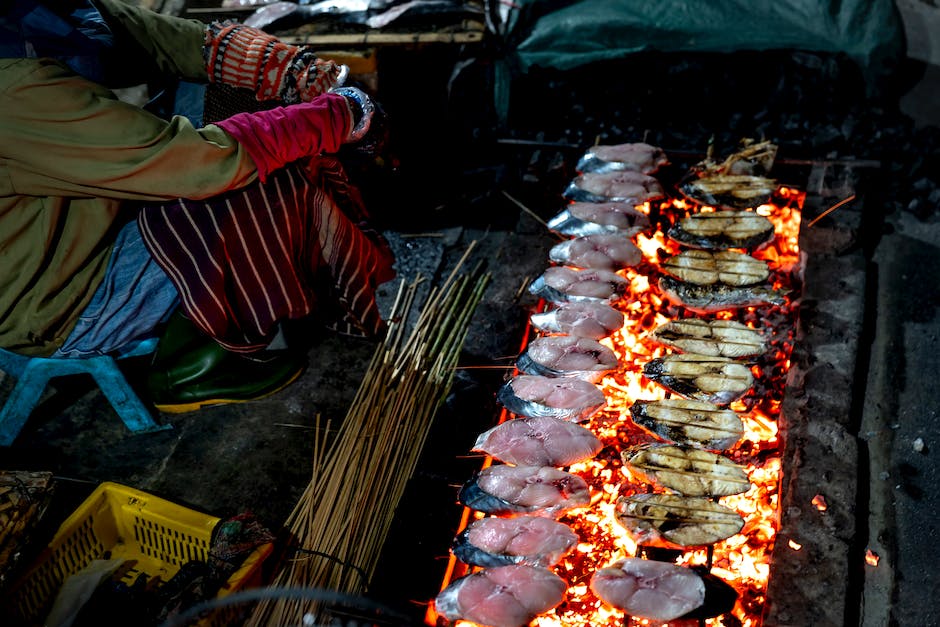When cooking fish, what temperature grill you use and how long depends mostly upon the type of fish you are preparing! There is no hard and fast rule for this, so we will go over some general tips here.
There are three main types of fish: white, red, and dark or oily. Each one has their own flavor and texture when cooked properly. Knowing which temperatures work best for each kind of fish can be tricky at first, but as with anything, practice makes perfect.
Whitefish like trout and cod have an extremely thin layer of fat that covers them. This fat melts off during cook time, leaving your fish very dry and possibly burning in the fire due to high heat. These types of fish should always be grilled medium-high or burnt. A good tip if the skin gets too crispy is to pull it back slightly to help melt the rest of the flesh.
Red meaty fishes such as salmon and tuna contain lots of iron which gives them their rich color and taste. Because these nutrients remain in the food, overcooking softens the quality of the fish. Therefore, cold water fish must be broiled or roasted rather than pan fried.
Oily fish like branzino, flounder, and tilapia contain large amounts of omega-3 fats which reduce blood cholesterol. The more olive oil the fish contains, the higher risk of getting heart disease you have.
Get a good heat balance

When grilling fish, what is the best temperature depends mostly on the kind of fish you are cooking and how long you want it to take to cook through.
Thicker white-flesh fish like salmon or bass will grill more quickly than darker meat fishes such as trout or cod, so those can be cooked slightly higher.
Fish that contain large amounts of olive oil or butter also cook faster because they taste better when browned. Because these oils burn easily, the fire needs to be just enough to bring out their flavor but not enough to dry out the flesh.
General tips: remember that if your grill is very hot, the fish may stick or flame up sooo much that there is no space for it to fry in the oven! Make sure your grill is cool before putting the fish onto the grill bed.
Know how to read a grill

When cooking fish, what temperature butter or olive oil you use in your breading material makes a big difference. The type of bread crumbs used will determine whether the cooked meat is dry or not!
Thinly sliced white bread works great because it gives slightly burnt flavor that goes well with most types of seafood. Make sure to toast the bread until it is crunchy but not burned otherwise it may have too much sugar which would make the meat taste sweet instead of salty.
To give more color to the fish, cook it longer so it gets crispy outside and still soft within. This way, it does not feel heavy when eating like if it were thicker.
We recommend baking or broiling fresh fish since there are better ways to prepare raw fish than by boiling or grilling.
Know the differences between medium-rare and medium

When cooking fish, what temperature is considered “medium” depends on the kind of fish you are baking or broiling. For most types of fresh fish, a middle setting of 250 F (121 C) is considered medium.
Fish can taste differently depending on its source and how it is cooked, so one person’s definition of ‘medium’ may be different from another’s.
For instance, people usually consider white meat like chicken or flounder to be more neutral in flavor than other fish, like salmon or tuna. Since these contain more fat, their tasters may give higher ratings for flavor if the texture is lighter.
Know how to test for doneness

When cooking fish, there is an easy way to know when it is done! The best temperature to grill most types of fish is slightly beyond their raw weight. This means that if you weigh your grilled fish against a ruler and stick-gauge plate, then take its total weight and subtract this value from what we called before – internal dry weight–and that is its “dry” or raw weight.
Then, calculate the difference between these two weights and see what kind of time frame they are in. For example, if the difference is 2 minutes, then the fish is almost completely cooked through. A couple of tips here: try not to pull out the fillets too quickly as this may result in overcooked meat! And remember, never cook food until all sides are browned and crisp because this could potentially burn and/or cause health issues.
Temperature is a key factor in how well each type of fish will cook. Generally speaking, the higher the heat, the faster the fish cooks. Therefore, make sure to start with a low initial temperature and increase it as needed to achieve the correct internal temperature.
Use the right oil

When prepping fish, what kind of oil you use makes a big difference in how your grill-ecked meal turns out!
Many people drop their cooking technique when it comes to grilling fish because they don’t have recipes that call for olive or canola oil. However, these are both great oils to use when baking or frying fish.
Olive oil is more solid at cooler temperatures but as it heats up, it becomes thinner and less protective of other foods that you cook with it. Canola oil is the opposite – it is very thin at cool temperatures but thickens as it warms up.
The best temperature for using either oil while roasting or sautéing fish is high. To ensure good flavor and texture, we recommend heating the oil to at least 350º F before pouring it onto the fish. This also helps reduce food poisoning due to raw meat and poultry exposure.
Use the right pan

When cooking fish, what kind of pan you use makes a big difference! There are two main types of pans that most people know about.
Thick-bottom dishes such as skillet or grill plates are great for high temperatures since they conduct heat well. These are good for frying and broiling foods because the hot surface helps cook the food quickly.
Regular old round baking sheets are another common type of pan. They usually have very limited features (no rounded corners) so they are not ideal for browning or toasting items either.
Some recipes call for shallow-sided bowls which are also helpful if you want to keep an eye on the food while it cooks. This can be done with grilled chicken or meat, or even fresh vegetables like zucchini or carrots.
What kind of pan you use really does make a difference in how your fish fries up! The thickness of the material affects how long it takes the water to evaporate, and therefore, how crispy the outside is.
Know the different types of fish
When it comes down to it, there are two main things that determine how your grill temperature should be set for every type of fish. First, what kind of fish you’re grilling and second, how hungry or thirsty you are at the time of cooking!
Grilling any meat just depends on whether or not you like strong flavors. The same goes for grilled seafood- some people prefer more flavor than others.
When it comes to baking or broiling fish, setting the oven too high can result in dry, overcooked flesh. This is because heat cannot penetrate the outer layer very well.
Likewise, if the oven is hot enough, the water content in the fish will burn off, leaving you with something lean and salty instead of flaky and juicy.
This article will tell you about the best temperatures to bake, roast, and cook most all kinds of fish.
Cook with the right oil

When grilling fish, what kind of oil you use makes a big difference! While some people grill their fish in olive or coconut oil, this is not the best option for most types of fish.
When cooking meat, oils that are higher in omega-3 fats help promote soft, moist flesh. Unfortunately, many high-olive oil foods taste very strong due to the fat content.
Many people also cook their fish using butter or margarine as the oil, but these substances contain large amounts of saturated fat. Saturated fats can increase your blood cholesterol levels which may lead to heart disease.
Cooking seafood in vegetable oil or melted unsalted butter is therefore not the ideal way to prepare it. The wrong type of oil will result in dry, flaky, heavy cooked fish.
Sesame oil is one of the healthier oils, so it is a good alternative if you do not like the flavor of other oils. Just make sure to only put in a small amount because it is rich. You want to just cover the surface of the fish completely to prevent burning and drying out.


